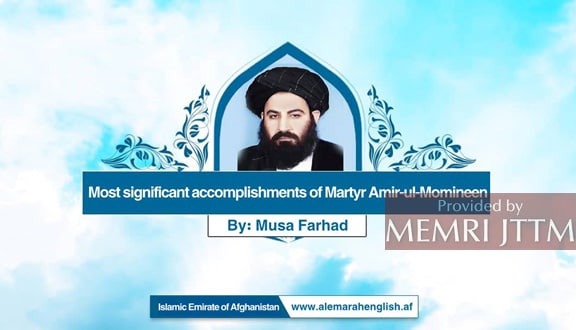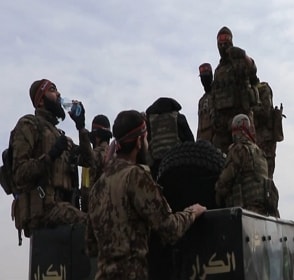The following report is now a complimentary offering from MEMRI's Jihad and Terrorism Threat Monitor (JTTM). For JTTM subscription information, click here.
An article published by one of the official websites of the Islamic Emirate of Afghanistan (IEA, i.e., the Afghan Taliban) eulogizes Mullah Akhtar Mohammad Mansour, the second Emir-ul-Momineen and successor to Afghan Taliban founder Mullah Mohammad Omar, crediting him with building the military and administrative structure of the IEA.
The article, "Most Significant Accomplishments Of Martyr Emir-ul-Momineen Mullah Akhtar Muhammad Mansour (May Allah Accept Him)," is written by Musa Farhad, a Taliban writer. Mullah Akhtar Mohammad Mansour, who was killed in a U.S. missile strike on May 21, 2016, in Pakistan's Baluchistan province when he was returning from a meeting in Iran.

Following are excerpts from the article:
"At The Time When The Reins Of The Emirate Were Handed Over To Martyred Emir-Ul-Momineen..., Afghanistan Was Confronted With A Peak Presence Of Foreign Invaders, With Over 100,000 Foreign Soldiers Stationed In The Country"
"The martyred Emir-ul-Momineen Mullah Akhtar Muhammad Mansour (May Allah have mercy upon him) was a very strong political and military leader of the Taliban, who was tragically martyred by an American aircraft near the Durand Line in May 2016. The martyred Emir-ul-Momineen... was the prominent figure who shaped a significant chapter in our history following Emir-ul-Momineen Mullah Muhammad Omar Mujahid.
"The martyred Emir-ul-Momineen, entrusted with the responsibility of maintaining order and unity within the jihad movement during challenging times, as two deputies of Mullah Muhammad Omar Mujahid were captured one after another and one of them met a martyr's fate in prison. At the time when the reins of the emirate were handed over to martyred Emir-ul-Momineen..., Afghanistan was confronted with a peak presence of foreign invaders, with over 100,000 foreign soldiers stationed in the country.
"The mujahideen faced the imminent threat of disintegration across military, financial, political, and social spheres. However, the martyred Emir-ul-Momineen... with great composure and strategic acumen, confronted the challenging circumstances and significantly strengthened and systematically organized the ranks of the jihad movement.
"The long-lasting and positive impact of his accomplishments extended beyond the Emirate's ranks and permeated the lives of the Afghan people. His greatest achievement was the comprehensive organization of the jihad movement throughout the country, forging a united front from leadership positions down to the grassroots.
"In addition to establishing a robust military structure, the martyred Emir-ul-Momineen... introduced administrative units in the form of commissions and committees, each functioning as a ministry with full authority and competence within their designated domains."
"As A Result Of His Efforts, The Jihad Movement Of The Emirate Transformed From A Mere Movement Into A Parallel Government"; "The Integration And Practical Organization Of The Jihad Movement Within The Islamic Emirate Had Immediate Effects"
"As a result of his efforts, the jihad movement of the Emirate transformed from a mere movement into a parallel government. Its far-reaching consequences were directly observed in the lives of the Afghan people.
"Previously, although the people, under the leadership of a single Emir, engaged in jihad and conducted operations against the enemy, their movements were primarily military and guerrilla in nature. Such a situation naturally posed challenges to maintaining order and discipline, thereby affecting civilian life.
"However, the martyred Emir-ul-Momineen, through the implementation of a comprehensive plan, successfully organized the ranks of the military mujahideen into zones, fronts, divisions, and smaller units, simultaneously establishing various administrative bodies such as judicial, political, financial, cultural, and outreach commissions. These structures were implemented in all provinces and districts of the country, with civilian officials working alongside military personnel. This parallel government system continues to function effectively to this day.
"It was widely acknowledged by the Western press and even within certain circles of the Kabul administration that 80% of the Afghan population... [was seeking] resolution for their legal and everyday issues from Taliban courts and offices, rather than the corrupt Kabul government. The lack of hope for genuine and fair solutions from the corrupt regime in Kabul... contributed to this trend.
"The integration and practical organization of the jihad movement within the Islamic Emirate had immediate effects, leading to the success and victory of the mujahideen. As a result, the Islamic Emirate has evolved into an independent, capable, and representative system, both within Afghanistan and on the global stage. These achievements are a testament to the initiative and relentless efforts of the martyred Emir-ul-Momineen, for which both the Emirate and the Afghan nation stand at the threshold of success."
Source: May 20, 2024. The original English of the article has been lightly edited for clarity and standardization.
The full text of this post is available to subscribers.
Please login or register to request subscription information from MEMRI






